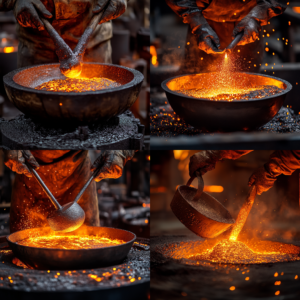Have you ever wondered how carbon additives are shaping the foundry industry? They're more than just ingredients – they’re game-changers for casting quality and cost.
- Carbon additives, like recarburizers, play a critical role in improving castings by enhancing their quality, reducing defects, and optimizing costs. They're essential to modern foundry operations.
In the previous article, we provided a detailed explanation of what carbon additives are and how to choose a carbon additive factory.
Let’s explore how these carbon additives work their magic, and how they’re making a real difference in the foundry world.
How Do Carbon Additives Impact Casting Quality?
Carbon additives improve casting quality by controlling carbon content, helping to reduce defects and improve the overall structure of the material.
- By adding the right carbon additives, foundries can achieve better casting results, minimizing defects and improving mechanical properties.
When you add carbon to cast iron, it influences many aspects of the material’s properties, including hardness, wear resistance, and strength. However, choosing the right type of carbon additive is crucial. If you add too little, the casting might be too weak; too much, and it could become brittle. Let’s break it down with a comparison table to see the effects on different types of castings.
Carbon Additives and Their Role in Reducing Defects
The right carbon additive can minimize common casting defects such as shrinkage, porosity, and cracks. Let’s take a closer look at this in the table below:
| Type of Carbon Additive | Impact on Defects | Best For |
|---|---|---|
| Graphite | Reduces shrinkage, cracks | Castings requiring high durability |
| Calcined Pet Coke | Reduces porosity and surface defects | High-strength castings for heavy industries |
| Recarburizer | Improves hardness and strength | Iron castings in automotive industry |
Why Are Carbon Additives So Important in the Foundry Industry?
The foundry industry relies on carbon additives to fine-tune the chemical composition of cast metals. They help improve mechanical properties and ensure consistency across products.
- Carbon additives like recarburizers are crucial for the production of high-quality castings, helping to control the carbon content and optimize metal properties.
Think of the foundry as a delicate balance between science and artistry. The carbon additive isn’t just a filler – it’s a key player in the process, affecting everything from the casting’s strength to its lifespan. Without the right balance, defects could overwhelm the production process. It's almost like the recipe for a cake: the right ingredients in the right proportions make the difference between success and failure.
The Role of Recarburizers in Foundry Operations
Recarburizers are essential to the foundry industry for controlling carbon levels. Their use in foundries is a key component in achieving the desired mechanical properties of castings.
- Recarburizers, often made from petroleum coke or graphite, are widely used to adjust carbon levels, ensuring the quality and strength of castings.
In fact, recarburizers can be considered the “secret sauce” of many foundry operations. By increasing the carbon content during melting, they help achieve a specific target for hardness and wear resistance. This is especially critical when producing castings for industries like automotive or heavy machinery, where performance is paramount.
Common Types of Recarburizers in Foundries
Here’s a quick look at the most common types of recarburizers and how they influence the final product:
| Type of Recarburizer | Carbon Content | Ideal Use Case |
|---|---|---|
| Petroleum Coke | 85-95% Carbon | Used in high-strength iron castings |
| Graphite | 90-99% Carbon | Used for high-durability castings |
| Synthetic Recarburizer | 95-99% Carbon | Preferred for precise carbon control |
How Can Carbon Additives Help Reduce Costs?
Aside from improving quality, carbon additives are a cost-effective way to enhance the performance of castings, saving foundries money in the long run.
- By optimizing the carbon content, foundries can reduce material waste, lower energy costs, and produce better quality castings at lower prices.
Dive-Deeper paragraph: The savings from using the right carbon additive are significant. Not only do you reduce waste by controlling carbon more precisely, but you also reduce rework and the need for expensive repairs. This leads to smoother operations, fewer defects, and better bottom lines for businesses. It’s a win-win situation for foundries.
Conclusion
Carbon additives are vital to the foundry industry for improving casting quality, reducing defects, and cutting costs. They play a pivotal role in creating durable, high-performance materials.
Call to action
Looking to optimize your foundry operations with the best carbon additives? Reach out today to discuss how we can help your foundry achieve superior results. Email us at [email protected], or connect via WhatsApp: +86 18202528603.


